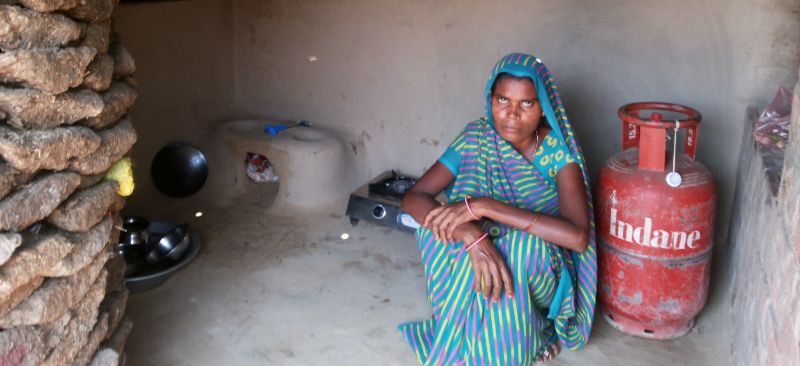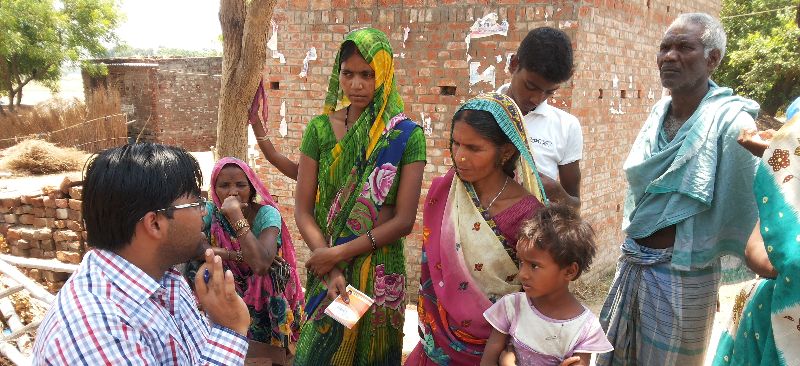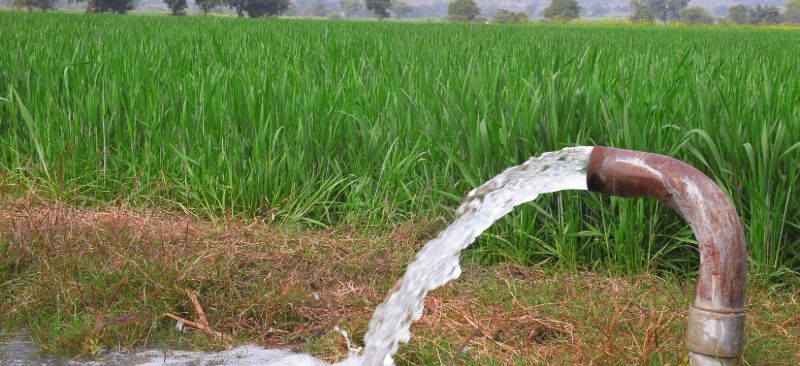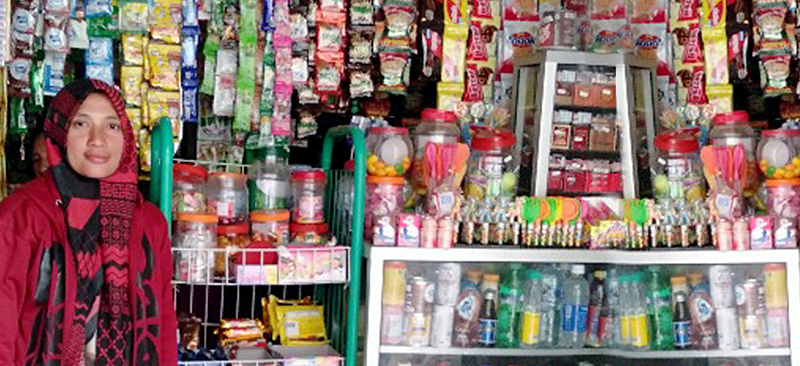Blog
Optimizing groundwater usage through DBT in electricity: Lessons from Punjab-Part II
Part I of this focus note discussed how free power to the agriculture sector has led to the overexploitation of groundwater in India and the response of the Punjab government—a pilot program for Direct Benefit Transfer in Electricity (DBTE). This part highlights major challenges from the demand and supply-side perspectives. It also recommends ways to address these challenges and explores how DBTE can be scaled up in other states as well.
Universal Basic Income: A policy option for India?
Governments around the world are rushing to mitigate the economic fallout from the COVID-19 pandemic, particularly on lower and middle-income groups. Among the range of proposed responses, the idea of a Universal Basic Income (UBI) has gained prominence. The United States has already begun providing cash transfers of USD 1,200 to all taxpayers, adjusted depending on income levels, while Spain is considering a minimum income transfer to vulnerable households to provide subsistence assistance and catalyze economic activity. The political and academic circles in India to have seen similar calls for a UBI in the country as a financial safety net to tide over an uncertain labor market in a post-COVID-19 scenario. Given the renewed interest in UBI, this blog will analyze the suitability of UBI in the Indian context.
1. What is UBI?
Universal Basic Income has taken distinct forms in different contexts depending on historical and geographical factors. While there might not be a standard definition of UBI, the fundamental tenants include:
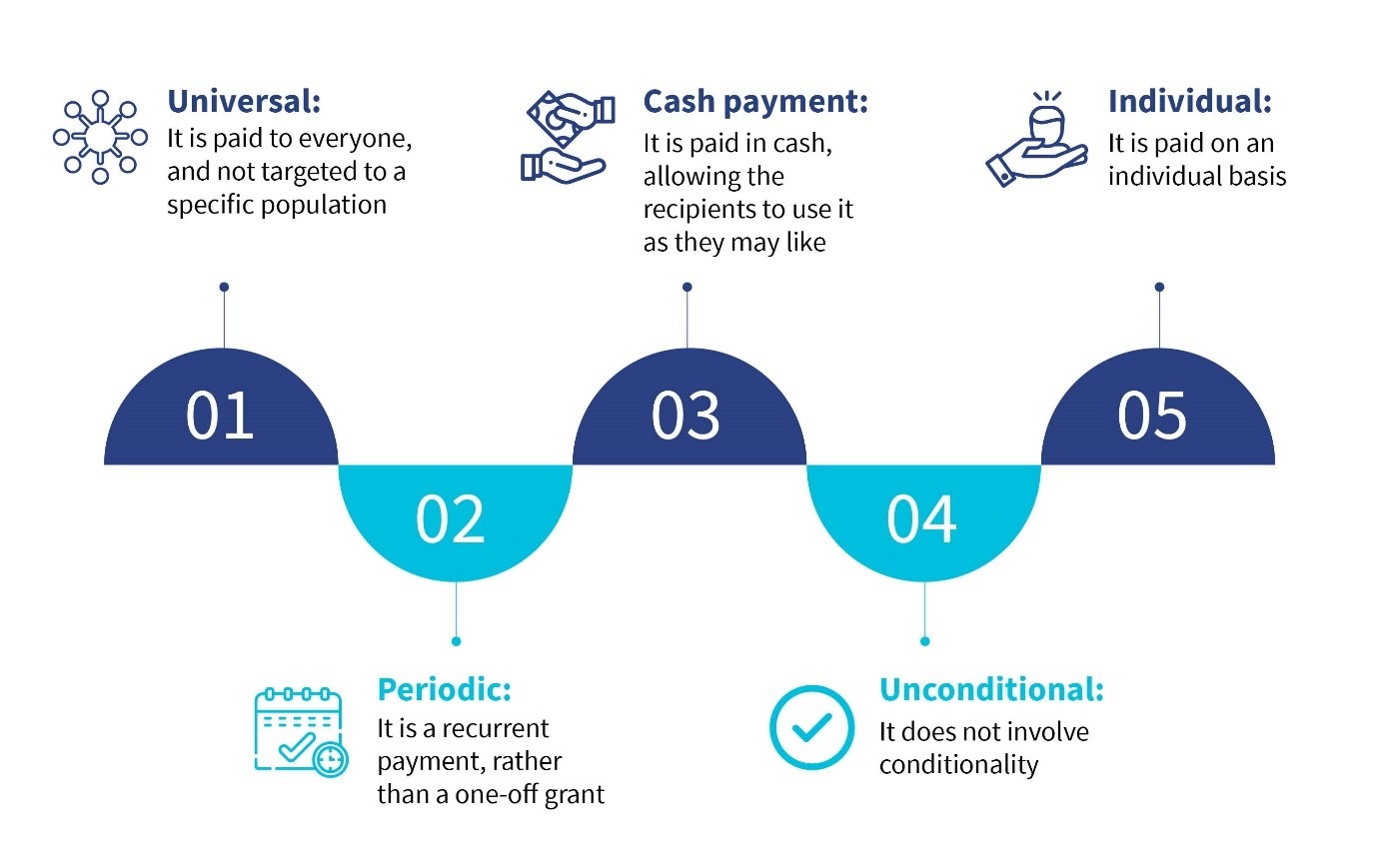
The concept of a UBI has both proponents and detractors. In developed countries, proponents of UBI recognize it as a solution to rising inequality and unemployment precipitated by technological advancements. Many see it as an alternative to the cumbersome “welfare state” and as a tool to alleviate poverty and provide a social safety net by covering subsistence needs. It is also favored in certain geographies like India because it gives more choice to recipients who currently receive in-kind transfers. Further, UBI seems appealing due to high administrative costs, leakages, barriers to enrolment, and inaccurate targeting that plague existing welfare initiatives.
On the other hand, critics of UBI, in both developed and developing countries, argue that a UBI would not be fiscally feasible to implement. They believe UBI defeats the objective of economic redistribution, discourages productive activity, and sparks inflation.
While a national implementation of UBI has not yet occurred, there have been multiple attempts to pilot variants of UBI or unconditional cash transfers at smaller scales in different countries. The charity GiveDirectly conducted trials on the effect of providing unconditional cash transfers to households in Siaya County in Western Kenya during 2014-2016. This exercise provides insights into the effects of a potential UBI.
The study found that 18 months after receiving the cash transfers, recipient households reported higher spending and an increase in durable assets. The higher demand for products and services also resulted in increased income among non-recipient households, which led to increased spending. However, the study reported that the gains accrued due to the income transfer were also unequal, with the households that were already well off gaining more than the poor households. This amplified the existing income inequalities in the village.
In Namibia, a two-year pilot project (2008-10) on a Basic Income Grant (BIG) was implemented in the Otjivero-Omitara area. All residents under the age of 60 received NAD 100 (USD 6.7) each month without conditions attached. The positive impact of the project included lower household poverty levels alongside increased attendance and lower dropout rates in schools. However, since the BIG was only implemented in Otjivero-Omitara, there was a significant migration towards the area, resulting in a 24% decrease in per capita income.
2. UBI in the Indian context
There have been trials on UBI in India, as well. SEWA Bharat, supported by UNICEF India, conducted a pilot on basic income transfer in the rural areas of Madhya Pradesh from 2012 to 2013. For the pilot, two categories of villages were identified—village and tribal village. For each category, a set of control villages was identified. An amount of INR 300 (USD 4) per adult and INR 150 (USD 2) per child as basic income was distributed unconditionally to all individuals within the village for 12 to 17 months, without imposing eligibility requirements. The results were encouraging with pilot villages performing better on parameters including open defecation, electricity connections, drinking water, nutrition, and food sufficiency when compared to the control group.
The Government of India’s (GoI) Economic Survey 2016-17 catalyzed discussions around UBI in India. These discussions explored the possible effect of UBI on various social development parameters, such as poverty reduction, social justice, and administrative efficiency. The discussion, in part, focused on the significant number of central sector and centrally sponsored sub-schemes (950) in India, such as food and fertilizer subsidies, employment guarantee programs, and scholarships, among other social assistance programs.
These schemes have varied targeting mechanisms, conditionality requirements, and modes of implementation. These targeting mechanisms are often crippled by exclusion and inclusion errors and high bureaucratic costs, resulting in inefficiencies and sub-optimal effectiveness. GoI’s Economic Survey 2016-17 posited that the implementation of UBI could substantially overcome these issues.
We could argue that over several decades, the GoI has taken small steps toward a quasi-UBI by implementing different modes of Direct Benefit Transfer (DBT) programs. The cash transfer in food subsidy pilot (2015) in the three union territories of Chandigarh, Puducherry, and Dadra and Nagar Haveli is an example of the shift from in-kind to cash transfers by the GoI. Under this pilot, all beneficiaries of the Public Distribution System (PDS) were entitled to receive cash transfers instead of rations received through PDS shops. Overall, beneficiaries were indifferent, yet the monetary savings realized by the GoI was significant in the range of 10% to 15% of the food subsidy bill.
Another unconditional and recurring income transfer program launched by the GoI in 2018 is PM Kisan, which entitles all landholding farmers to INR 6,000 (USD 80) annually. PM Kisan most closely mimics a UBI in India with the only conditionality being that the recipient must qualify as a landholding farmer, subject to a few exclusions. Over time, the program is expected to cover 140 million beneficiaries. These policy measures have created an environment in which the GoI could shift to UBI without significant friction in the future.
3. Designing an Indian UBI
The transition from existing government social welfare subsidy payments to UBI would require the GoI to address questions around eligibility, frequency, and amount of basic income to be provided. Yet questions remain around whether the government can comprehensively implement UBI, or if it would require a tailor-made approach. The following section details ways to address some of these foundational issues.
Is universality an option?
One of the core precepts of UBI is that it is universal in nature, which means all the citizens are, by default, beneficiaries. Adopting a universal approach in India would certainly result in higher government expenditures, while simultaneously ensuring that no citizens are excluded. This approach does away with the traditional mechanisms of delivering subsidies prevalent in India, which include defining a universe of beneficiaries and selecting from that universe.
Yet implementing UBI would be unaffordable in a country like India, where 22% of the population is classified as below the poverty line. This is because adopting a UBI would come at the cost of providing benefits to upwards of 78% of the population who would not need it immediately.
A better model for India would be to start with a targeted approach. Although this appears to be more affordable, it has its own set of challenges, including those around identifying the target segment (the poor) and limiting the flow of benefits to them. A targeted approach would require a robust database of beneficiaries and clear guidelines around exclusion parameters. Such an approach has always been subject to exclusion and inclusion errors. While wrongful inclusions lead to unnecessary expenditures, wrongful exclusions defeat the program’s purpose.
To address this, the GoI should develop a dynamic database in the long term, which can be used for beneficiary identification. The Socio-Economic Caste Census (SECC, 2011) can be utilized for immediate rollout since it captures the socio-economic profile of households in the country comprehensively. Although a targeted approach would stop short of a true UBI, it would have a significant impact on India’s population living below the poverty line. For a developing country like India, a quasi-universal basic income makes greater economic sense.
Can a UBI be a substitute for the existing welfare system?
The second major issue to be addressed is how a UBI would fit into the existing social welfare ecosystem in India. Estimates indicate that a UBI designed as a full supplement to existing social welfare schemes in India would add up to 13% of the current GDP and, therefore, is not fiscally feasible. On the other hand, the existing discourse (including the Economic Survey of 2016-17) rests on the idea that a UBI budget would replace all existing welfare programs. However, there are multiple issues with this approach.
First, rolling back programs meant to ensure food security and improve educational outcomes and sanitation, among others, would not only require backtracking on the achievement of human development goals but would not be politically viable. Welfare infrastructure, such as health care centers, plays an important role in nudging beneficiaries toward responsible behavior, particularly through social proofing.
Second, directly substituting UBI for the existing in-kind welfare programs ignores the additional transaction costs that would be borne by beneficiaries. These transaction costs include transport costs to access cash from banks, and wages lost as opportunity cost during travel and wait time. Third, some beneficiaries have expressed a preference for receiving in-kind subsidies—imposing a UBI ignores this preference. Fourth, clubbing existing benefits to make way for UBI will need a systemic overhaul because there are many backward and forward linkages. For example, PDS is linked to the Minimum Support Price (MSP) provided to farmers.
Finally, evaluation of cash transfer programs has thus far shown significant last-mile challenges including enrolment problems, Aadhaar seeding and authentication issues, delays in transfers, and gaps in grievance resolution.
Perhaps rather than view this as an “all or nothing” choice, policymakers should look at the middle road by implementing a supplementary income transfer to the targeted population. The GoI should retain existing in-kind programs that deliver necessities and enhance one’s quality of life, such as food security, sanitation, and education. Over time, once the GoI demonstrates that it has built a stable system that can reach the poorest through income transfers, it could revisit certain policies including giving beneficiaries the ability to select from different service providers, that is, existing public services or non-government providers.
This will empower beneficiaries by allowing them to decide how their social welfare funds could be spent. It could also potentially enhance the quality of public services by introducing competition with private or civil society organizations to attract business from the poor. In the long run, this could usher in greater accountability and efficiency among service providers.
Conclusion
Designing an Indian UBI requires an understanding of the constraints of the feasibility of universality and substituting existing welfare subsidies—and tailoring the program accordingly. In essence, a UBI in India could be implemented as a supplemental, unconditional, recurring cash transfer to the target population while keeping the existing welfare infrastructure intact. This approach mitigates concerns regarding financial viability by making incremental shifts to the welfare delivery ecosystem and introducing more choice to beneficiaries.
However, the GoI should first conduct a pilot study to understand the short-term and long-term effects that a basic Indian UBI would have on incomes, labor markets, communities, and beneficiary preferences. Only then should it throw its weight behind what is an extremely complicated and far-reaching program.
References;
What is UBI?, Stanford University
SEWA Bharat is a federation of women-led institutions that provides economic and social support to women in the informal sector
USD = INR 75
‘Piloting basic income transfers in Madhya Pradesh’, SEWA Bharat, January 2014.
The Economic Survey of India reviews the developments in the Indian economy over the past financial year, summarizes the performance of major development programs, and highlights policy initiatives of the government and the prospects of the economy in the short to medium term.
Central Sector Schemes are the programs that are entirely and directly funded and executed by the central government.
Centrally Sponsored Schemes are programs that are implemented by state governments. However, the cost of these schemes is borne by the central and state government on a shared basis. Under the cost ratio, the larger portion is always borne by the central government.
The exclusion error fails to target the intended beneficiary population of the scheme. In contrast, the inclusion error causes funds to be spent on non-deserving populations, which leads to inefficiencies and budget increases.
Economic Survey of India 2016-17, Government of India; Himanshu and Abhijit Sen (2013), “In-kind food transfers—I: impact on poverty,” Economic & Political Weekly Volume 48 Issue No. 45-46.
Direct Benefit Transfer (DBT) is a mode of delivery of G2P payments launched by the GoI to transfer benefits and subsidies of various social welfare schemes directly into the bank accounts of beneficiaries.
Optimizing groundwater usage through DBT in electricity: Lessons from Punjab-Part I
Free or highly subsidized power to farmers in India has led to overconsumption of groundwater by the agricultural sector. The situation has reached a near-crisis level in many states due to these high subsidies. Unique models like Paani Bachao, Paise Kamao (Save water, earn money), the Direct Benefit Transfer in Electricity (DBTE) introduced in Punjab, offer a politically feasible and effective solution to the persistent issue of overuse of groundwater
Energy-water-agriculture linkages
‘Surviving a pandemic’: Five key insights from the Corner Shop Diaries research in India and Indonesia
Ishwar Sharma, the only bread earner in his family, runs a small café in a town in northern India. Meanwhile, Alus, a mother of two, runs a small grocery store in Central Java, Indonesia.
The COVID-19 pandemic and the “economic pandemic” that followed have brought Ishwar and Alus to the same point. These misfortunes had hit the businesses of both micro-entrepreneurs badly.
In Ishwar’s case, people become reluctant to buy his food and beverage due to health concerns, as he prepares the items he sells onsite. His troubles were compounded by the prolonged closure of businesses during lockdowns, which translated to fewer customers, alongside new competition from the reverse-migration by people returning from the cities who set up small cafes in his neighborhood.
As for Alus, her customers—mostly local farmers—became cash-strapped due to the significant drop in crop prices. Furthermore, the prices for basic groceries have surged during the pandemic (for instance, the price for cooking oil jumped 33% higher), and Alus’ customers had to either limit their purchase or pay for their groceries later.
Both micro-entrepreneurs are, however, striving to keep their businesses afloat.
MSC’s research on the impact of COVID-19 on MSMEs in India indicates that 73% of the businesses surveyed had reported a decrease in customer footfall. Meanwhile, three-fourths of the enterprises reported a decline in income. Meanwhile in Indonesia, 79% of MSMEs surveyed reported a drop in sales volume by a median of 50%; and 51% reported that they kept operating as usual but the overall number of customers per day had decreased by a median of 50%.
From October, 2020, MSC started to track the daily financial life of 25 corner shops each from India and Indonesia using the Financial Diaries methodology. We have collaborated with the social enterprise Low-Income Financial Transformation (L-IFT), to track the daily financial transaction of corner shops. These corner shops are small retail businesses located in neighborhoods that sell daily needs products and provide essential services.
The daily financial data of these shops generate intriguing insights into how these corner shops are in the process of recovering from the COVID-19 pandemic and the challenges they face.
In this blog, we discuss five insights from the early data of this research.
- In India, owners of the small daily provisions store have become risk-averse and restricted their ambition.
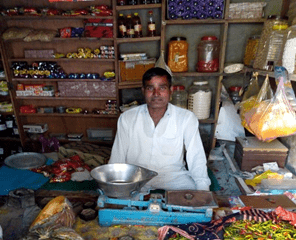 Varun Singh, father of two teenagers, runs a small daily necessities store in the north-west part of India. He mentioned during the interviews that his monthly gross income was INR 15,000 (USD 206) per month before the pandemic, which dropped to INR 8,000 (USD 110) per month during the pandemic.
Varun Singh, father of two teenagers, runs a small daily necessities store in the north-west part of India. He mentioned during the interviews that his monthly gross income was INR 15,000 (USD 206) per month before the pandemic, which dropped to INR 8,000 (USD 110) per month during the pandemic.
The data that we collected in the past two months of 2020 indicates that he is yet to attain his pre-COVID level of business (see Graph 1).
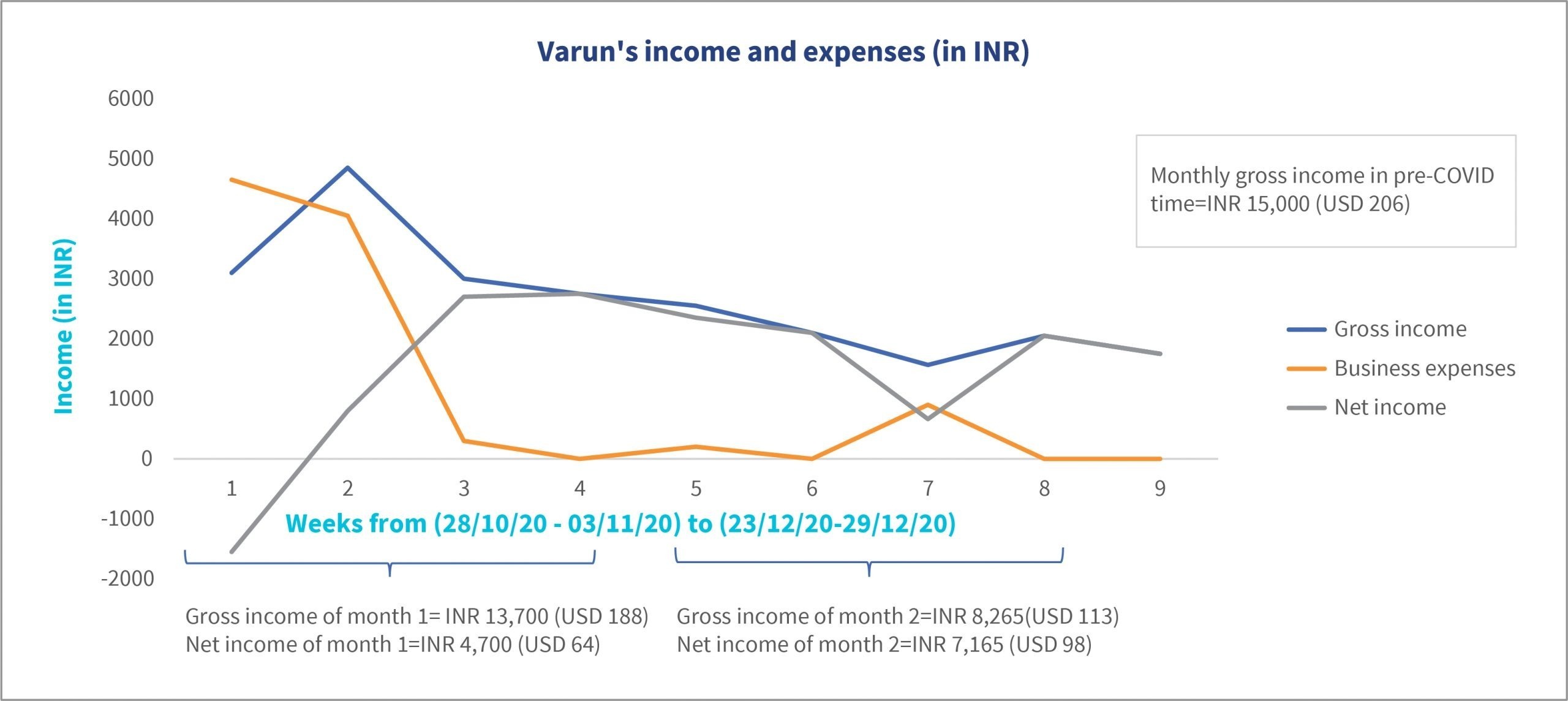
Graph 1
Varun has been running his small shop from home although he wanted to buy or rent a shop in the market area. Despite difficulties, he wanted to grow his business. Yet the financial and health-related risks related to the pandemic have convinced him to postpone his planned expansion and continue operating from the current location.
Many corner shop owners in our sample also think along similar lines. Even though customer footfall has returned to normal, they are buying less compared to pre-COVID-19 times. Hence even if the income of the shops has picked up gradually, is still not what it used to be.
The financial stress and the experience of losing near and dear ones have made the corner shop owners risk-averse.
- In Indonesia, many corner shops managed to maintain their regular income during the pandemic. For some, the pandemic helped to increase revenue.
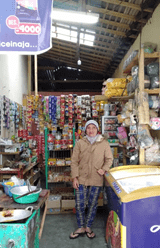 Hening, a young mother of two, runs a corner shop in Central Java. She sells staple foods, cooking oil, snacks, sweets, tobacco and cigarette, medicine, gas, and toys. She could maintain her usual sales revenue even during the pandemic (an average of IDR 30 million or USD 2,146 per month).
Hening, a young mother of two, runs a corner shop in Central Java. She sells staple foods, cooking oil, snacks, sweets, tobacco and cigarette, medicine, gas, and toys. She could maintain her usual sales revenue even during the pandemic (an average of IDR 30 million or USD 2,146 per month).
The data from the Diaries (Graph 2) indicates that Hening’s average monthly gross income is IDR 29 million (USD 2,074). It shows a drop in November, 2020 (Week 7) but only because Hening had to close her shop for around two weeks to help with some wedding events.
The revenue of Hening’s shop was soon back to normal—and even increasing—once she returned to the business (see Graph 2).
Hening has maintained her sales revenue during the pandemic by using some simple strategies. For instance, she stopped selling airtime as many of her customers often pretend they didn’t receive the top-up so they can refuse to pay –forcing Hening to cover the cost herself. As Indonesia did not restrict shop operational hours, Hening also kept her usual opening hours, that is, 6 am to 9 pm daily during the lockdowns. She also implemented hygiene protocols when the pandemic was at its peak by providing hand sanitizer outside the shop for customers’ use to make them feel safe.
Moreover, Hening has started to prepare better budgeting for her business and personal finance. She also uses her business data to map her income and expenses better and also allocated some money for saving.
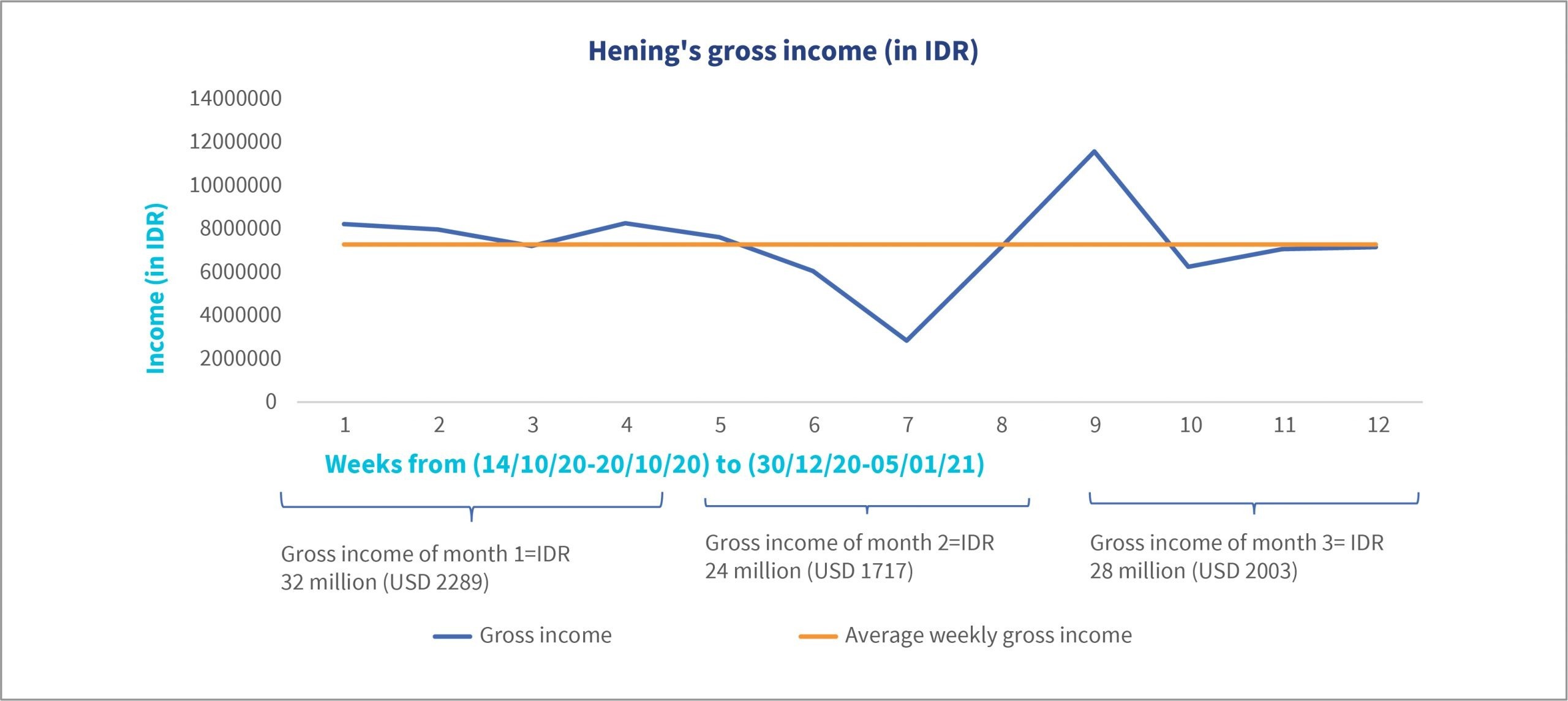
Graph 2
Many corner shops in our sample adopted several simple strategies. These included following health protocols to make customers feel safe, prolonging operational hours to increase customer footfall, and reducing the number of staff members. The corner shops also adjusted their product or service mix to sell items in high demand or commanding a higher market price and stopped the sale of unprofitable or less-profitable items.
The strategies have helped corner shops to maintain their income or even make more profit than in earlier years.
- Corner shop owners are beginning to think digital.
In India, multiple corner shop owners, such as medicine shops, barbers, and cafés, among others, told us during interviews that they have started to accept digital payments, most commonly from PhonePe or Google Pay from clients during the pandemic. This phenomenon is mostly observed among younger diarists. We have also seen the use of messenger apps and social media to market products and services. Some diarists have also started to accept orders from regular customers through WhatsApp.
In Indonesia, we found multiple diarists using their WhatsApp and Facebook accounts to promote their business; mostly to generate awareness among customers about any new product or service they have started to sell. We also found that the micro-entrepreneurs use WhatsApp to communicate with suppliers. Some diarists use e-commerce sites, such as Shopee, Tokopedia, or Bukalapak to buy stocks at cheaper rates and sell specific products, such as plastic furniture. Only two of our diarists use digital payments to settle bills through ShopeePay, and pay suppliers and accept payments from customers through OVO and LinkAja. However, this had been their practice for a couple of years before the pandemic.
Many diarists were interested in using e-commerce in the future. Yet juggling between the brick-and-mortar shop and the online store requires time and energy. They also have concerns about the cost of internet data; hence they have become reluctant.
- CICO agents in India saw increasing footfall but declining income during the lockdowns.
Our sample from India has three dedicated CICO agents and all of them mentioned that the pandemic has hit their businesses. These three CICO agents reported the total monthly net income of INR 38,000 (USD 521) before the pandemic, which fell by 24% to INR 29,000 (USD 398) during the pandemic.
The four major reasons for the decline in income are:
- Reverse migration, which has decreased remittance;
- Most withdrawals were small in value, which increased footfall but not income;
- Worrying about cash crunch during lockdowns, many people withdrew their savings through the BC agents, thus creating liquidity issues for the agents;
- Owing to mobility restrictions, agents could not travel to rebalance their liquidity, which also hampered the business.
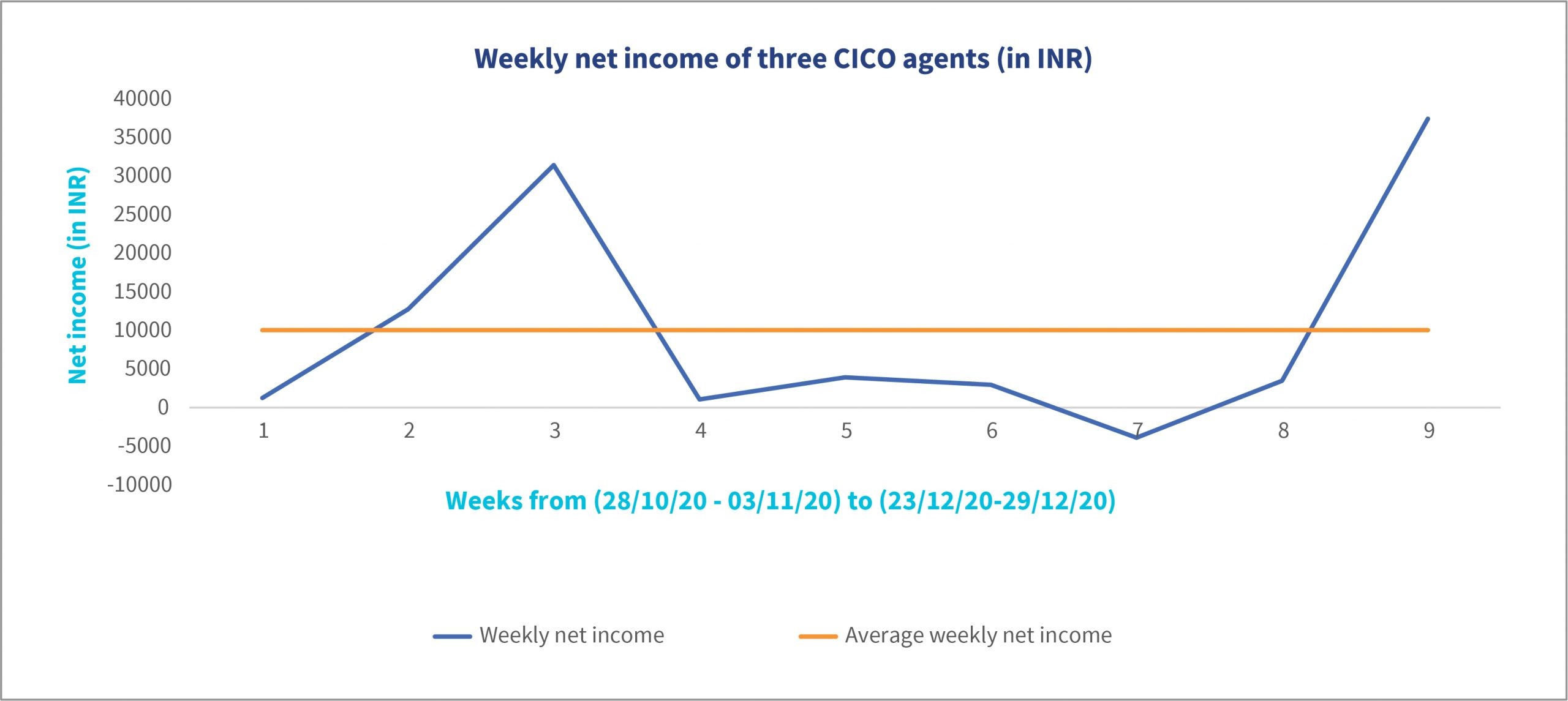
Graph 3
However, the business has picked up now. Graph 3 shows the average monthly income of INR 40,108 (USD 550), which is similar to pre-COVID-19 times.
- Women who own corner shops have faced unique challenges during the pandemic.
Social norms and caregiver responsibilities created an extra set of challenges for women who own corner shops. As traditional gender roles are still prevalent, we observed our women diarists struggle to manage their unpaid work at home and responsibilities at the shop.
One respondent from Indonesia mentioned that as schools are closed and children are at home, she struggled to manage her shop and the children. For another respondent, the extra pressure of earning for the household, since her husband lost his job, and fulfilling her duties as the caregiver made her life very stressful.
In India, a few women-owned enterprises reported that their husbands used to help them for tasks where mobility is required, such as withdrawing cash, repairing business assets, and buying supplies, among others. Yet the COVID-19 pandemic posed a challenge as their husbands had to work harder to earn money and could not help at their wife’s business.
To conclude, we highlight that financial conditions and the adoption of digital means are dynamic processes that change rapidly. One-off surveys can capture the situation at one point in time but fail to capture the transition and the volatility. Fortunately, the Corner Shop research can bridge this knowledge gap.
This blog is an introduction to the Corner Shop Diaries project, the first of a series that will be published regularly this year. We will also publish regular data-based insights on our website, and combine these insights with actionable recommendations for policymakers and practitioners.
This series will touch upon different themes, including the adoption of digital payments and e-commerce by micro-businesses, savings and loan products that they need, and their behavioral changes over time. Be sure to stay updated for more insights from us.
